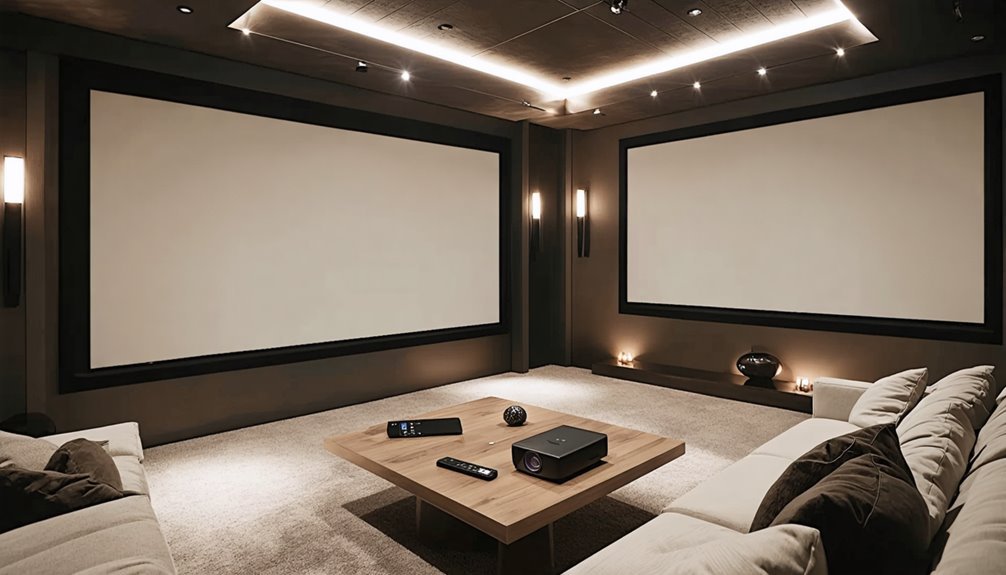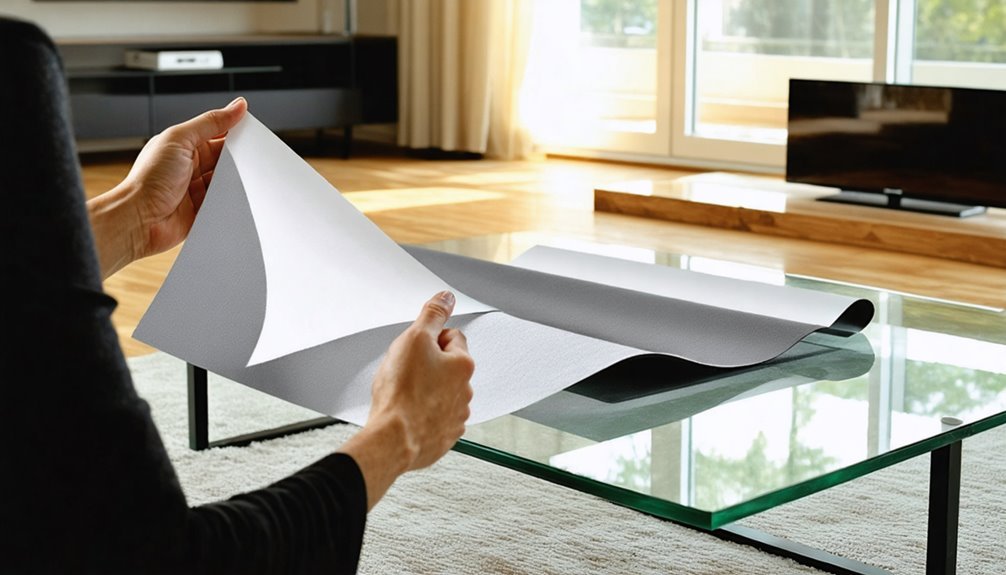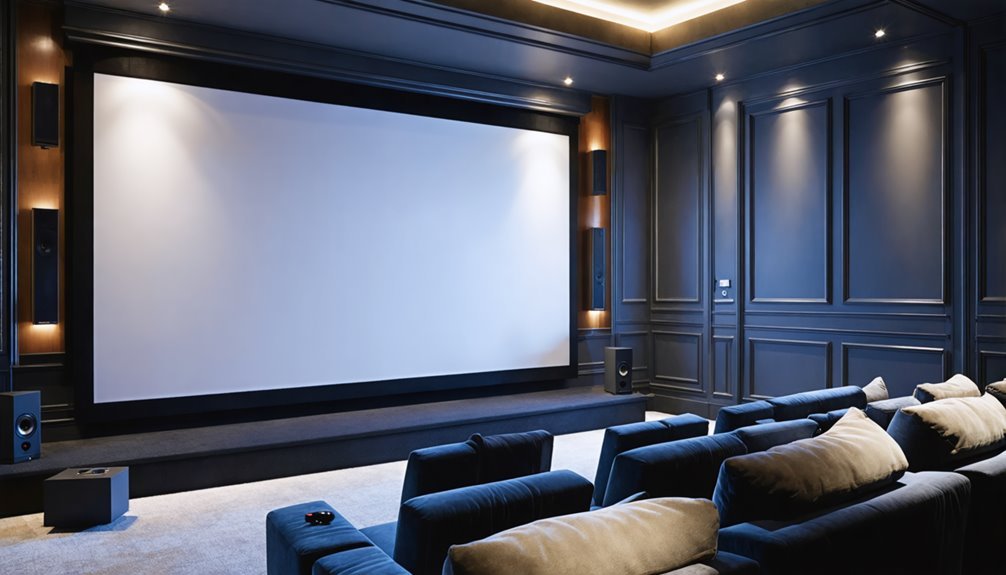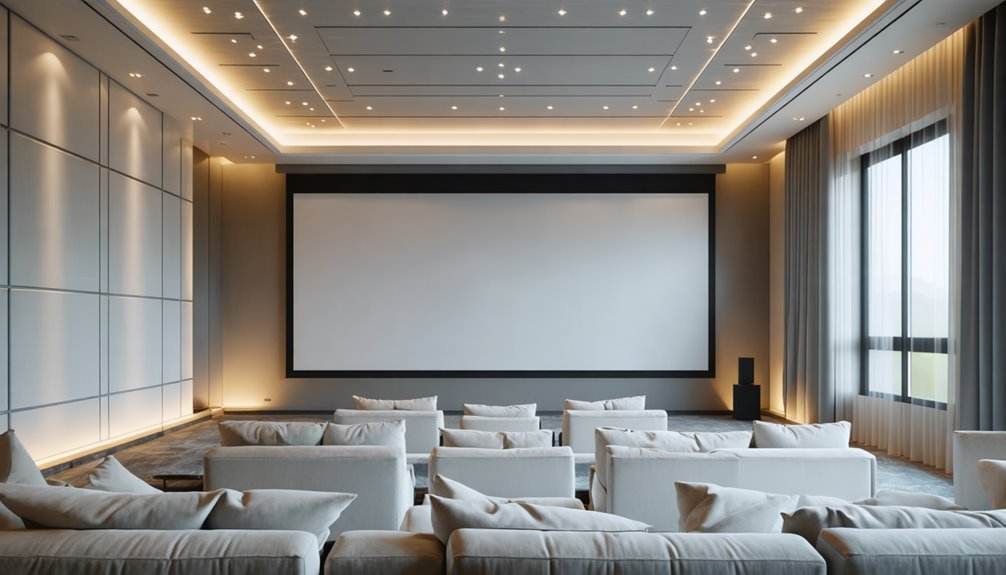How to Choose: Manual Vs Electric Projector Screens

When choosing between manual and electric projector screens, weigh your space, budget, and how often you’ll use it. Manual screens are simple, cost-effective, and fit well in flexible or smaller setups, but require hands-on effort. Electric screens offer remote convenience and seamless integration for frequent use, though they cost more and often need professional installation. Consider image quality, ease of use, and upkeep. Curious how these factors play out in real-world scenarios? You’ll uncover more practical insights ahead.
Main Points
- Consider your budget—manual screens are more affordable with lower installation and maintenance costs, while electric screens require higher investment and possible professional installation.
- Evaluate ease of use—electric screens offer remote operation and automation, whereas manual screens need physical handling each time.
- Assess installation flexibility—manual screens allow DIY setup and relocation, while electric screens offer permanent, professional mounting options.
- Review daily usability—electric screens are convenient for frequent use or presentations; manual screens are better for occasional or portable setups.
- Check room space and projection quality—electric screens provide precise automated alignment, while manual screens may need frequent adjustments for optimal image display.
Space Requirements and Room Fit
When selecting a projector screen, you’ll need to assess your room’s available space and layout before deciding on the right type and size.
Start by checking for obstructions—doors, windows, or trim that might interfere with a large screen, especially if you crave a cinematic 100″ or 120″ display. Your wall or ceiling should provide a clear, uninterrupted surface that matches both the screen’s dimensions and your projector’s throw ratio. Screen dimensions impact installation and room layout, so careful planning ensures the screen will fit comfortably and enhance your viewing experience.
Scan for doors, windows, and trim—your dream screen needs a wide, clear expanse to deliver that immersive cinematic feel.
Cramped spaces? A ceiling-mounted motorized screen can retract and disappear, freeing your walls and preserving flexibility.
If you value easy DIY solutions, a manual screen can be relocated or removed without hassle, but it will occupy wall space constantly.
With fixed screens, you’re committing to a permanent installation, which limits your ability to reinvent your space later on.
Prioritize horizontal and vertical alignment so every seat gets a clean view, matching screen height with eye level to maximize your room’s potential.
Budget Considerations and Upfront Costs
When you’re weighing projector screens, you’ll notice a wide gap in upfront prices between manual and electric models.
Don’t forget to factor in installation and maintenance costs, as these can quickly affect your total budget.
Let’s look at what you can expect to spend both at purchase and over time. Many trusted retailers offer projector screens from reputable brands like Elite Screens, Draper, and Da-Lite, which can also influence both cost and long-term value. You’ll also find a range of discounted projector screens with features like anti-light technology and portable designs, helping you maximize value regardless of your initial investment.
Upfront Purchase Price Comparison
Projector screens come in a wide range of upfront prices, so it’s important to know what you get for your budget.
Entry-level manual screens start under $300—like Akia’s portable for $109.99 or Kodak’s pull-up for $249.99. Surprisingly, basic electric options such as the Elite Spectrum motorized appear at $197, so price doesn’t always align with tech. Many shoppers outside the United States can take advantage of these deals by shopping in the U.S. and having orders shipped to any valid U.S. address.]
Moving to mid-range models, manual screens hit around $324.99, while electric screens often rise from $300 to $800, sometimes adding features like tab-tension systems.
At the high end, premium electric screens soar to $6,000, especially with advanced materials like ALR.
Meanwhile, you’ll find fixed-frame manual options, like Valerion’s $1,199 screen, rivaling mid-tier electrics, proving that liberation from old limits isn’t always tied to a specific screen type.
Installation and Maintenance Expenses
Price tags only tell half the story—getting your screen up and running introduces its own set of expenses. When you choose an electric projector screen, expect the need for professional installation, electrical outlets, and sometimes even structural reinforcement if you’re going ceiling-mounted.
These hidden costs can trap you in technicalities—licensed electricians, smart-home hubs, and occasional fire compliance standards all add layers you mightn’t want. Heavier screens are harder to roll down, so electric models may also require extra materials or support if your ceiling or wall needs reinforcement.
Manual screens, on the other hand, invite you to take control: DIY installation is usually straightforward, with no costly wiring or infrastructure.
Maintenance is liberating, too—it’s as simple as occasional dusting and making sure the roller runs smooth. Electric screens demand regular motor checks and battery attention.
For those craving freedom, a manual screen keeps life (and your budget) hassle-free.
Everyday Usability and Control Features
When it comes to everyday use, you’ll notice that electric projector screens offer effortless remote operation, making setup quick and easy. Many electric and manual screens come in multiple screen sizes to suit different rooms and needs. Manual screens, on the other hand, demand more hands-on handling each time you use them.
For larger rooms or spaces where the screen is mounted high up, electric screens bring an added benefit, as their precise stopping point feature ensures that the screen can be lowered just to the right position without accidental overshooting or causing potential damage.
You’ll also want to evaluate how customizable position settings can improve viewing accuracy and overall convenience.
Effortless Remote Operation
Although convenience has become a top priority for modern viewing spaces, remote operation sets electric projector screens apart from their manual counterparts.
With a wireless remote, you can raise or lower your screen effortlessly from anywhere in the room—no need to interrupt your flow or cross the room. Manual projector screens, in contrast, require you to physically pull them down each time, offering a cost-effective solution but lacking this hands-free advantage. One-touch controls make starting your movie night or presentation instant and seamless.
Integration options, like wall-mounted switches or compatibility with smart home systems, let you shape your setup to fit your needs. Want the screen to drop when the projector does? Synchronize them for true automation.
Preset heights and memory functions let you recall your preferred position with ease. Effortless operation means you’re in control, free from hassle, and unburdened by clunky, outdated routines.
Manual Handling Requirements
While electric projector screens offer automation at your fingertips, manual screens demand hands-on interaction and a bit of daily attention.
You’ll pull down the screen by its handle, feeling the resistance of the spring-loaded mechanism as you lower or retract it—each use is a physical engagement. This process gives you direct control but necessitates commitment every time you set up for a viewing. The auto-locking system featured in many manual screens allows you to set the height at precise intervals, giving you greater control over your viewing area.
For those craving autonomy and tactile involvement, consider these daily usability aspects:
- Frequent manual operation can cause fatigue, especially with larger screens or repeated use.
- Adjusting spring tension and performing occasional maintenance guarantees smooth, consistent function.
- Physical proximity is necessary—expect to reach up or climb occasionally, especially with wall or ceiling mounts.
- Manual screens suit low-to-moderate use but can challenge users with limited strength or dexterity.
Customizable Position Settings
If you’re seeking effortless control and adaptability in your projection setup, customizable position settings on modern projector screens can transform your viewing experience.
With wireless or IR remote compatibility, you can adjust the screen from anywhere, removing the limits of manual reach. Fixed Frame Projector Screens, which are permanently installed and don’t require shifting, can offer additional stability and reliability for users who want a more seamless integration with programmable position settings. Programmable presets let you save preferred heights for movie nights, presentations, or gaming, so you spend less time fiddling and more time enjoying.
Smooth, precise motorized movement and auto-locking guarantee stability at any position, while incremental digital controls eliminate frustrating manual adjustments.
For shared spaces, multi-user remote options and preset profiles cater to everyone’s needs. Integration with smart home systems means you can command your screen with your voice or phone—total liberation from cables, rods, or awkward manual tension adjustments.
Installation Demands and Maintenance Needs
When deciding between motorized and manual projector screens, you’ll notice significant differences in both installation demands and ongoing maintenance.
If you crave flexibility and dislike being tied down, manual screens are far simpler to mount—just screws or adhesive strips, no wires, no fuss. Outdoor projector screens often come in portable designs that further simplify the setup process for manual options.
Motorized screens, on the other hand, often demand professional installation and electrical work, which means more planning, labor, and sometimes extra costs.
Maintenance is also less liberating with motorized options, since motors and gears may require periodic lubrication, repairs, or troubleshooting, while manual screens only need occasional spring adjustments. The moving parts in motorized screens increase the likelihood of needing regular maintenance compared to the straightforward mechanism of manual options.
Here’s what you’ll want to evaluate:
- Motorized screens need a dedicated power source; manual screens are electricity-free.
- Manual screens offer DIY-friendly installation; motorized versions may need pros and tools.
- Motorized options have more components to fail; manual screens are mechanically simpler.
- Maintenance costs add up faster with motorized screens.
Choose what supports your lifestyle—simplicity or automation.
Image Alignment and Projection Quality
After considering installation demands and maintenance, pay close attention to how your screen choice impacts image alignment and projection quality.
With an electric projector screen, you gain precise alignment thanks to preset stopping points and remote-controlled adjustments. This means less fiddling and fewer chances for misalignment or distortion—no more wrestling with a tug-of-war pull-down.
Electric models automate height, width, and even aspect ratio changes, freeing you from manual recalibration and the limitations of fixed distances or tension. By contrast, electric screens can also address issues like mismatched aspect ratios automatically, ensuring the projected image always fills the screen without cutting off edges or leaving distracting blank spaces.
Manual screens, on the other hand, demand more from you. They’re prone to minor shifts with every use, so you’ll have to regularly fine-tune placement and tension.
Wrinkles, sagging, or subtle alignment drift can creep in, affecting your projected image’s clarity and symmetry.
If you want the freedom to set it once and trust in flawless visuals every time, electric screens deliver a smoother, liberated viewing experience with minimal user intervention.
Suitability for Various Use Cases
How do you know which projector screen best fits your space and needs? Start by considering the realities of your environment and what truly empowers your workflow.
Manual projector screens let you reclaim space, perfect for multi-purpose rooms and pop-up events where flexibility matters most. In contrast, electric screens give you hands-free operation—essential for large venues or busy offices with frequent presentations. Your budget and installation preferences also come into play. Manual screens save costs and simplify setup, letting you direct resources elsewhere.
Since electric projector screens require additional expenses for electrical configuration, be sure to account for this when planning your installation.
Let’s clarify suitability across distinct situations:
- Small classrooms or temporary setups? Choose a portable manual screen.
- Need easy, frequent operation in a dedicated boardroom? Pick an electric model.
- Desire multi-use home theater flexibility and minimal spending? Manual is your path.
- Want seamless, automated presentation flow in a large media room? Go electric.
Assess your priorities—mobility, frequency, cost, or automation—to claim the freedom you want.
Style, Versatility, and Room Aesthetics
While function and technology matter, the screen’s style and integration can make or break your room’s atmosphere. If you crave a liberated, seamless space, motorized screens offer powerful aesthetic flexibility—they disappear into cabinetry or ceiling, leaving no visual clutter when not in use. This keeps your decor clean and modern, supporting the multi-use potential of your room without sacrificing design consistency.
Motorized screens need professional installation, so planning their placement in advance ensures that they will blend smoothly with your room’s architecture and wiring.
You’re not locked into rigid setups, either. Motorized screens allow you to adjust screen length with precision, adapt the arrangement with remote or smart-home automation, and reconfigure for any room layout.
Need a screen just for occasional movie nights? You’ll love how it’s visible only when needed—total freedom from distraction.
Manual screens don’t require electricity, offering even more installation versatility (think balcony or wall), but they’re less likely to vanish completely.
For the most tailored look, both options come with color and finish choices, blending effortlessly into your vision.
Frequently Asked Questions
Can Projector Screens Be Integrated With Smart Home Systems?
You crave freedom, so break away from limits—yes, you can integrate projector screens with your smart home system.
Pair the push of a button with the thrill of a whispered command: automate electric screens with remote apps, voice assistants, or smart hub routines, while even manual screens bow to your will through clever retrofits and wireless modules.
Why settle for static control when you can orchestrate your entire home theater experience effortlessly and hands-free?
Are Electric Screens Noisier Than Manual Ones During Operation?
You’ll notice electric projector screens produce a steady hum from the motor as they move, while manual screens make noise only when you adjust them—often a sharp snap or gentle rustle.
If you crave a tranquil space, premium electric models with silenced motors can rival, or even beat, controlled manual screens for quietness.
Ultimately, choose what fits your need for freedom from noise without being chained to constant buzzing or abrupt snapping sounds.
How Do Weather Conditions Affect Screen Durability Outdoors?
When you set up your projector screen outdoors, weather becomes your main rival. You confront rain, humidity, blazing sun, and wind, all of which can batter your gear.
Unless you use weather-resistant materials—think UV-stable fabrics, sealed seams, and rust-proof frames—screens fade, mildew, or tear.
Don’t let storms dictate your plans: choose resilient screens and anchor them well. This way, you claim mastery over your open-air movie nights, no matter the forecast.
What Warranty Options Exist for Manual and Electric Projector Screens?
Imagine walking through a marketplace where you’re offered shields for every purchase—these are your warranties.
You’ll typically receive 1-2 years of protection for both manual and electric screens, with options to extend coverage up to 4 years through third-party providers.
Some plans even protect against accidents and offer in-home service, freeing you from repair hassles.
Bundle deals and extra coverage await, letting you break free from worry and claim peace of mind.
Can Screens Be Customized to Specific Aspect Ratios or Sizes?
You’re not locked into standard screen formats—you can absolutely customize screens to any aspect ratio or size you want.
Calculate your perfect dimensions, then use custom builders or masking systems to match your exact needs, freeing your content from confining borders.
Immerse yourself in GPU and resolution tweaks for pixel-precise setups.
Don’t settle for someone else’s limitations; you can design a viewing canvas as unique and boundless as your ambitions.








